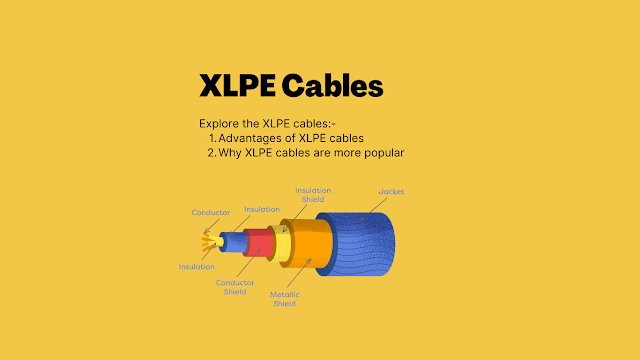XLPE Cables Applications and Advantages
·
Why is XLPE cables are Cross-Linked?
In
XLPE insulation cables the rubber is vulcanized with addition of Small
quantities of chemical additives. This will help to rearrange the molecular
structure into a lattice this process will hinders the movement of molecules in
the presence of heat.
XLPE cable is insulated with hydronic
tubing made of cross-linked polyethylene plastic (XLPE). The XLPE
insulation has a three-dimensional bond within the plastic. The insulation is
a thermoset, zero halogen insulation that provides flame retardant
properties. It is strong, durable, and temperature conducting.
This
process of vulcanization is being carried out to increase the stability of the
XLPE cables even at high temperatures. This process of Cross-linking
polyethylene also improves current carrying capacity i.e. rating of XLPE in
order to withstand higher short circuits and under normal load conditions.
By
this XLPE insulation, the problem of increased aging as a result of electrical,
environmental and mechanical stress is taken care of as well. After Cross
linking these cables can be used in the open air or buried (for underground
distribution) with no affect on current rating and heating of cables.
The cross-linking creates a molecular
bond which improves a number of resistances such as:
- Heat
deformation
- Abrasion
- Chemical
- Stress
Crack Resistance
Various Applications
of XLPE Cables:-
There
is an endless list of usage of XLPE cable now days. Every industry uses these
cables according to their needs. Few of applications of these cables are as
below:-
Due
to ability of withstand extreme temperatures and pressure these are used in mines.
Even at these extreme temperature and pressure these still maintain its
toughness that makes it a suitable material for mines.
Advantages of
XLPE Insulated Cables:-
1. XLPE
insulated cables are perfect for High voltage transmission. This is due to its
insulation properties. These cables are better than the other alternative
options available in the market such as Silicon rubbers, and even Ethylene
Propylene Rubber, EPR.
2. These
cables have better moisture resistant.
3. These
cables are better chemical resistant.
4. These
cables are better oil resistant.
5. These
cables possess better mechanical properties
6. These
cables have better impact resistance.
7. These
cables possess better elongation.
8. These
cables have better tensile strength.
9. These
cables saves time and cost during installation, maintenance and repair works.
10. During
transmission of high voltage from one point to another we observe sparking,
shocking and heat that could cause fire or other potential hazards. In XLPE
cables are better used for such purposes to avoid such type of instances.
11. These
cables requires less maintenance. XLPE cables doesn’t melt when there are high
temperatures and thus XLPE cables can take excess load per unit are without
fracture or tearing.
XLPE cable tubes have shape memory
characteristics, which only require heat to return it to its original shape.
Cross-linking is a very intricate
process. XLPE raw material powder is formed and processed into sturdy, durable
end products, usually formed into cylindrical shapes that can be used for long
tubing.
If during the cross-linking process
the degree is too high, the material could become brittle and cause stress
cracking. If too low, the physical properties could be very poor and unusable.
Made correctly, the tubing can act as a strong, long-lasting insulator to
various wires and cables, protecting it from all sorts of external elements.
XLPE is designed to replace
traditional galvanized steel, copper, and PVC piping due to rusting, cost and
circulation. Cross-linking can solve plumbing issues at competitive pricing and
can sometimes be easier to install.
Some of important features of these
cables are listed below:-
·
Hydrolysis resistance.
·
High electrical & insulation properties.
·
High extrusion speed.
·
Heat resistance.
·
Sunlight resistance.
·
Moisture resistance.


.png)



Comments
Post a Comment